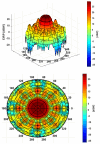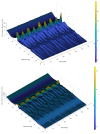3D Galileo Reference Antenna Pattern for Space Service Volume Applications
- PMID: 38610430
- PMCID: PMC11014402
- DOI: 10.3390/s24072220
3D Galileo Reference Antenna Pattern for Space Service Volume Applications
Abstract
There is an increasing demand for navigation capability for space vehicles. The exploitation of the so-called Space Service Volume (SSV), and hence the extension of the Global Navigation Satellite System (GNSS) from terrestrial to space users, is currently considered a fundamental step. Knowledge of the constellation antenna pattern, including the side lobe signals, is the main input for assessing the expected GNSS signal availability and navigation performance, especially for high orbits. The best way to define and share this information with the final GNSS user is still an open question. This paper proposes a novel methodology for the definition of a high-fidelity and easy-to-use statistical model to represent GNSS constellation antenna patterns. The reconstruction procedure, based on antenna characterization techniques and statistical learning, is presented here through its successful implementation for the "Galileo Reference Antenna Pattern (GRAP)" model, which has been proposed as the reference model for the Galileo programme. The GRAP represents the expected Equivalent Isotropic Radiated Power (EIRP) variation for the Galileo FOC satellites, and it is obtained by processing the measurements retrieved during the characterization campaign performed on the Galileo FOC antennas. The mathematical background of the model is analyzed in depth in order to better assess the GRAP with respect to different objectives such as improved resolution, smoothness and proper representation of the antenna pattern statistical distribution. The analysis confirms the enhanced GRAP properties and envisages the possibility of extending the approach to other GNSSs. The discussion is complemented by a preliminary use case characterization of the Galileo performance in SSV. The accessibility, a novel indicator, is defined in order to represent in a quick and compact manner, the expected Galileo SSV quality for different altitudes and target mission requirements. The SSV characterization is performed to demonstrate how simply and effectively the GRAP model can be inserted into user analysis. The work creates the basis for an improved capability for assessing Galileo-based navigation in SSV according to the current knowledge of the antenna pattern.
Keywords: GNSS; Galileo antenna pattern; accessibility index; antenna characterization; elastic-net regularization; high-orbit navigation; space service volume; spherical harmonic; statistical learning.
Conflict of interest statement
The authors declare no conflict of interest.
Figures



















References
-
- International Committee on GNSS (ICG) The Interoperable Global Navigation Satellite Systems Space Service Volume. 2nd ed. United Nations; New York, NY, USA: 2018.
-
- GPS Space Service Volume Ensuring Consistent Utility Across GPS Design Builds for Space Users. NASA; Washington, DC, USA: 2015.
-
- Marquis W., Reigh D. The GPS Block IIR and IIR-M Broadcast L-Band Antenna Panel: Its Pattern and Performance. Navigation. 2015;62:329–347. doi: 10.1002/navi.123. - DOI
-
- Enderle W., Gini F., Schönemann E., Mayer V. PROBA-3 Precise Orbit Determination Based on GNSS Observations, 32nd ed; Proceedings of the International Technical Meeting of the Satellite Division of The Institute of Navigation: ION GNSS+ 2019; Miami, FL, USA. 16–20 September 2019.
-
- Moreau M.C., Davis E.P., Carpenter J.R., Kelbel D., Davis G.W., Axelrad PMoreau M.C., Davis E.P., Carpenter J.R., Kelbel D., Davis G.W., et al. Results from the GPS Flight Experiment on the High Earth Orbit AMSAT AO-40 Spacecraft; Proceedings of the ION GPS 2002 Conference; Portland, OR, USA. 24–27 September 2002.
LinkOut - more resources
Full Text Sources

